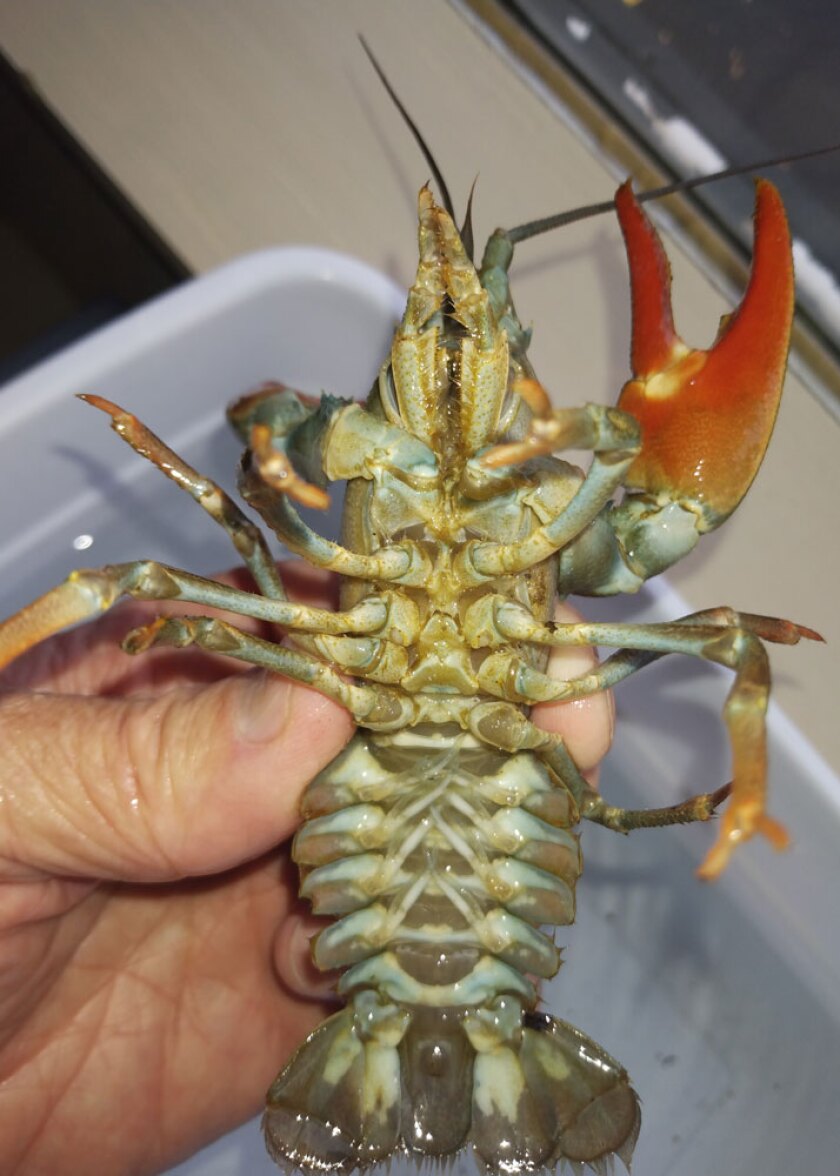ALEXANDRIA, Minn. — Yet another aquatic invasive species has invaded a Minnesota lake — this time the signal crayfish, a native of the Pacific Northwest confirmed in Lake Winona.
The Minnesota Department of Natural Resources confirmed the finding Friday and said a commercial crayfish harvester found two at one time in the lake and then found eight more later, including a female.
The good news is that there is no evidence the crayfish reproduced this summer and no additional signal crayfish were found in adjoining lakes so far.

Signal crayfish are larger and more aggressive than Minnesota crayfish. They can grow up to 7 inches long, tip of claws to tip of tail, and weigh up to 4 ounces, about three times more than native Minnesota crayfish. They eat aquatic plants, detritus, fish eggs, smaller crayfish species and other native invertebrates. Signal crayfish might out-compete native crayfish species for food and habitat and could impact fish populations.
The signal crayfish is native to the Columbia River drainage, with populations in Washington, Oregon, Idaho and British Columbia. The species is imported and sold through the pet trade, and sold to schools by biological supply houses, leading to the potential for illegal release into the wild.
ADVERTISEMENT
Like other invasive crayfish, including the large rusty crayfish that’s already invaded many Northland lakes, the signal crayfish can move some on its own, including crawling across land at night. However, it is more likely to be spread long distances by people, often unknowingly, by hitchhiking on a boat, trailer or bait bucket.
Some crayfish are brought live into Minnesota to be sold as human food for crayfish boils; others may be imported for aquariums. Releasing any of those into the wild is illegal.
“Importing live, non-native crayfish to Minnesota is illegal without a permit,” said Don Eaton, the DNR’s aquatic invertebrate biologist. “Regardless of species, it is illegal to release non-native plants or animals into the environment. “
Eaton praised the Minnesota crayfish harvester who noticed the unusual-looking invading species and reported it quickly.
Signal crayfish are bluish-brown to reddish-brown, with large, smooth claws and a smooth carapace — the protective covering over their head and midsection. They have a white or pale blue-green patch near their claw hinge, which looks like a signal flag.
People who believe they might have observed signal crayfish or other invasive species should note the exact location, take photos, keep the specimen and submit their observations to their local invasive species specialist at mndnr.gov/invasives/ais/contacts.html .
To help confirm sightings of signal crayfish, photos of the blue-green patches on claws, the bright red coloring on the underside of the claws and full-body views from above and below are ideal. Placing the crayfish next to a ruler or other-size reference is also helpful.
Zebra mussels confirmed in 3 Itasca County lakes
The DNR also confirmed Friday that zebra mussels have been found in Jessie Lake near Talmoon, Turtle Lake near Marcell and Trout Lake near Coleraine, all in Itasca County.
ADVERTISEMENT
A resort owner on Jessie Lake contacted the DNR after finding zebra mussels on a pontoon boat being removed for the season. Jessie Lake is upstream of and connected to other waters where zebra mussels were previously confirmed.
Itasca County Soil and Water Conservation District staff contacted the DNR after finding juvenile zebra mussels on equipment in Turtle Lake during an end-of-season inspection. Turtle Lake flows into the Bigfork River, where zebra mussels were previously confirmed.
Itasca County Soil and Water Conservation District staff contacted the DNR after finding juvenile zebra mussels on equipment in Trout Lake during an end-of-season inspection. Trout Lake is near Pokegama Lake, where zebra mussels were previously confirmed.
Lake property owners should carefully look for invasive species on the posts, wheels and underwater support bars of docks and lifts, as well as any parts of boats, pontoons and rafts that may have been submerged in water for an extended period.
Whether a lake has any invasive species, Minnesota law requires people to:
- Clean watercraft, trailers and equipment to remove aquatic plants and prohibited invasive species.
- Drain all water and leave drain plugs out during transport.
- Dispose of unwanted bait in the trash.
- Never release bait, plants or aquarium pets into Minnesota waters.
- Dry docks, lifts and rafts for 21 days before moving them from one water body to another.



















